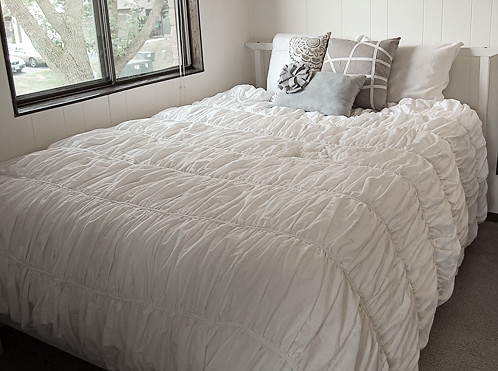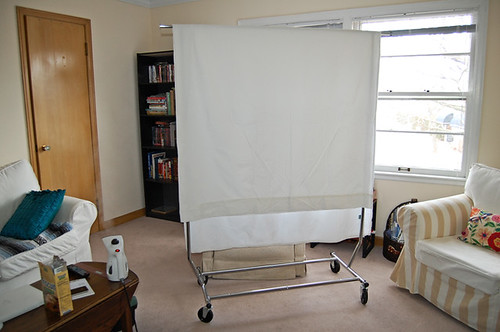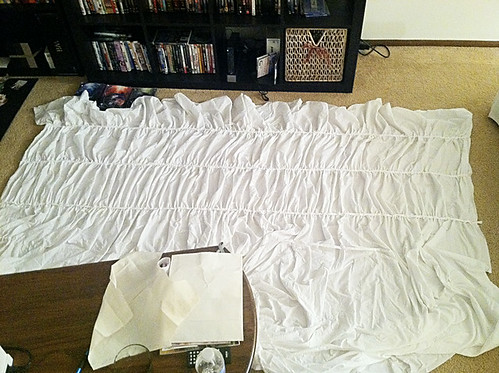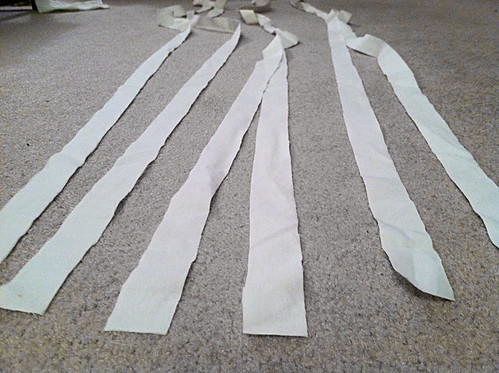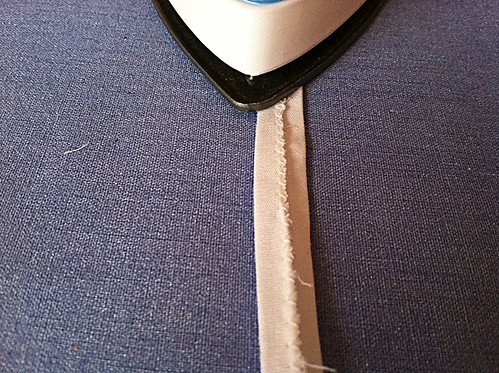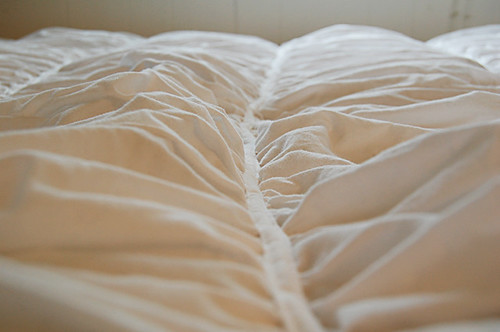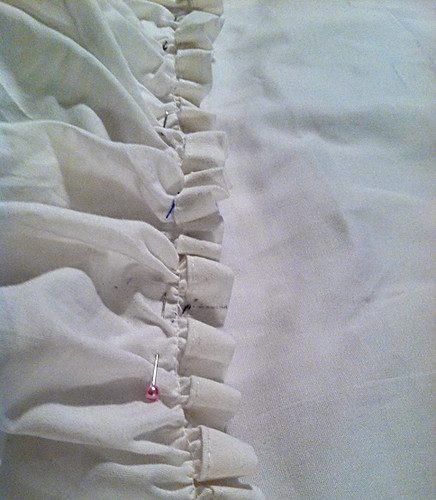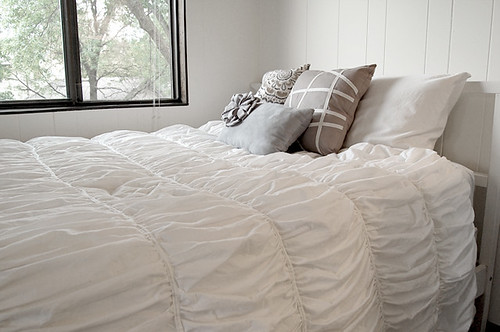I have an early Christmas present for you, I finally finished writing the tutorial for the Anthropologie Cirrus DIY duvet cover that I made this summer. Yay! So without further ado, here is my tutorial for the duvet cover:
Anthropologie Cirrus Bedding
My version
This tutorial is made to fit a full/queen sized comforter measuring 88 x 88 inches. Measure your comforter and adjust measurements to fit.
Materials:
2 king size flat sheets
1 queen size flat sheet (for reverse side of duvet)
matching thread
sewing machine
double needle – optional
some sort of closure, I used 3 yards of lace to create ties but buttons or snaps can be used
Sheets at Target about $15-$20 each depending on size
- First measure the duvet that will fit inside the cover to determine the size. Double the width (or more if you want a ton of gathers) and add an inch to both length and width to allow for seam allowance. My comforter was 88 x 88” so the measurements were 89” length by 177” width
- Wash and iron/steam the sheets to prepare them
I found the easiest way to get the wrinkles out is to hang the sheets up and steam them.
- Sew the 2 king size sheets together lengthwise
- Press the seam and spread out the sheets on a very large surface (like the floor) wrong side facing up
- Cut out the measurement that you took for the comforter so you have a piece of material 89 x 177” with the seam running the long way down the center. Save the extra fabric for use later!
- Divide the panel into 8 section horizontally, about 11” apart. It’s easier to pick a round number and have a little extra/less on the ends than trying to measure something like 11.362 inches between each section. Save yourself some headaches, you won’t be able to tell when it’s finished anyway
- Draw the lines on the wrong side of the fabric marking where the gathers will go
Mark on wrong side with pencil
- Sew down the lines with a basting stitch, leaving a few inches of thread hanging on each side
- Also baste along the top and bottom of the sheet with a ¼” seam allowance
- Gently pull one of the threads to gather the sheet to the proper width. (Mine was 89 inches, remember to include room for the seam allowance)
Pin down the strips over the gathered seams
Part 2: The Strips
- If you get bored sewing straight lines and gathering, you can start making the strips that will be sewn on top of the gathers to hold them in place. These will run the width of the comforter so use the width measurement again
- Cut 7 strips 1” wide by 89” long (or whatever the width of your duvet will be)
- Fold each strip in half lengthwise and sew together. I found using a zig zag stitch about ¼” from the edge was most effective and least stressful
- Press the strips so the seam is in the center
- Flip the strips over so the seam is facing down and lay on top of the gathered rows, but not the top or the bottom. Pin in place
- Sew the strips down. I found the best way to do this was to buy a double needle attachment for my sewing machine so I only had to do one pass, but if you don’t have one you can sew a narrow seam on one edge of the strip, and then go back and sew a narrow seam on the other edge
Part 3: The Back Panel
- Cut the remaining sheet to the proper length of the comforter (again, mine was 89 x 89” including seam allowance
- Take the extra fabric from the first two sheets. There should be enough left over to make a top panel. I made the top panel 1½ feet long by 89” wide
- Sew a 3” hem on one end. This will overlap the bottom panel and be tied together to hold the duvet inside
- Lay the front panel right side up on the ground. Decide which end will be the top and lay the top panel wrong side up on top of it with the sides matching. Lay the bottom part of the back panel even with the bottom and sides of the front panel, wrong side up. Pin ½” from the edge all the way around the duvet cover to hold everything together
- Sew around entire cover
Part 4: Closures
- Decide how you want to have the cover close. I decided to do 5 lace ties
- I measured 14” between each tie and pinned a 6” strip of lace to the back sides of the back top and bottom panels
- Sew down the ties (or if you’re really ambitions, create button holes and attach buttons)
- Flip inside out and stuff your duvet inside. Tie the lace into pretty bows
And you're done!
I hope that was clear enough to help, please feel free to ask any questions you might have while making it!
Linking up with East Coast Creative

